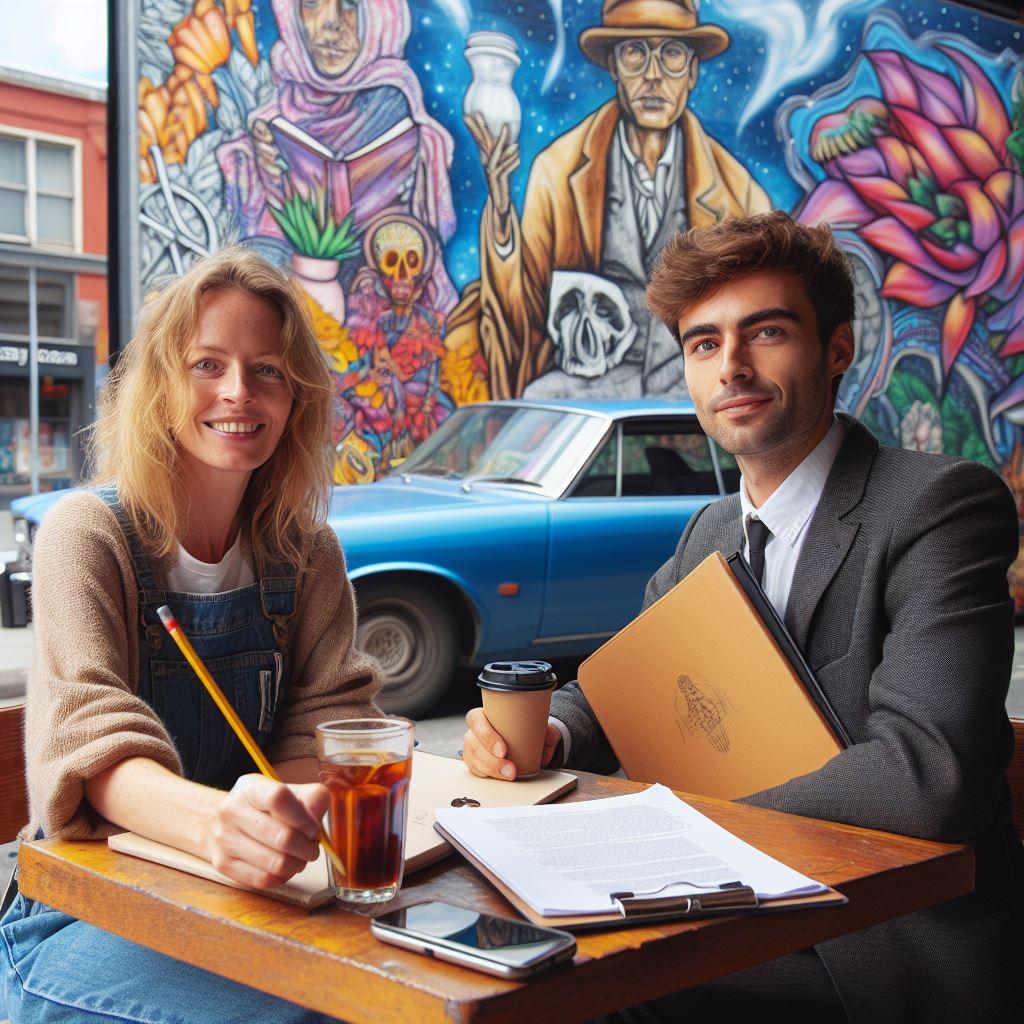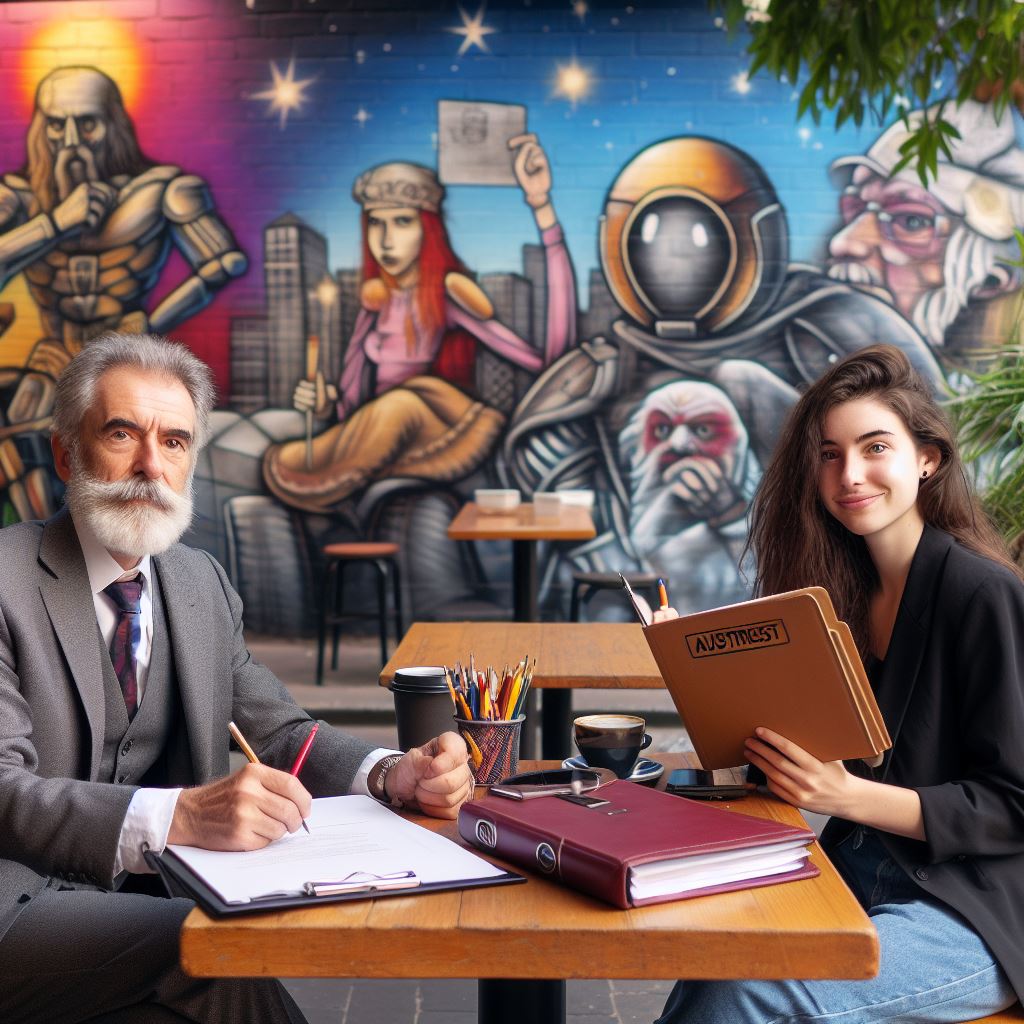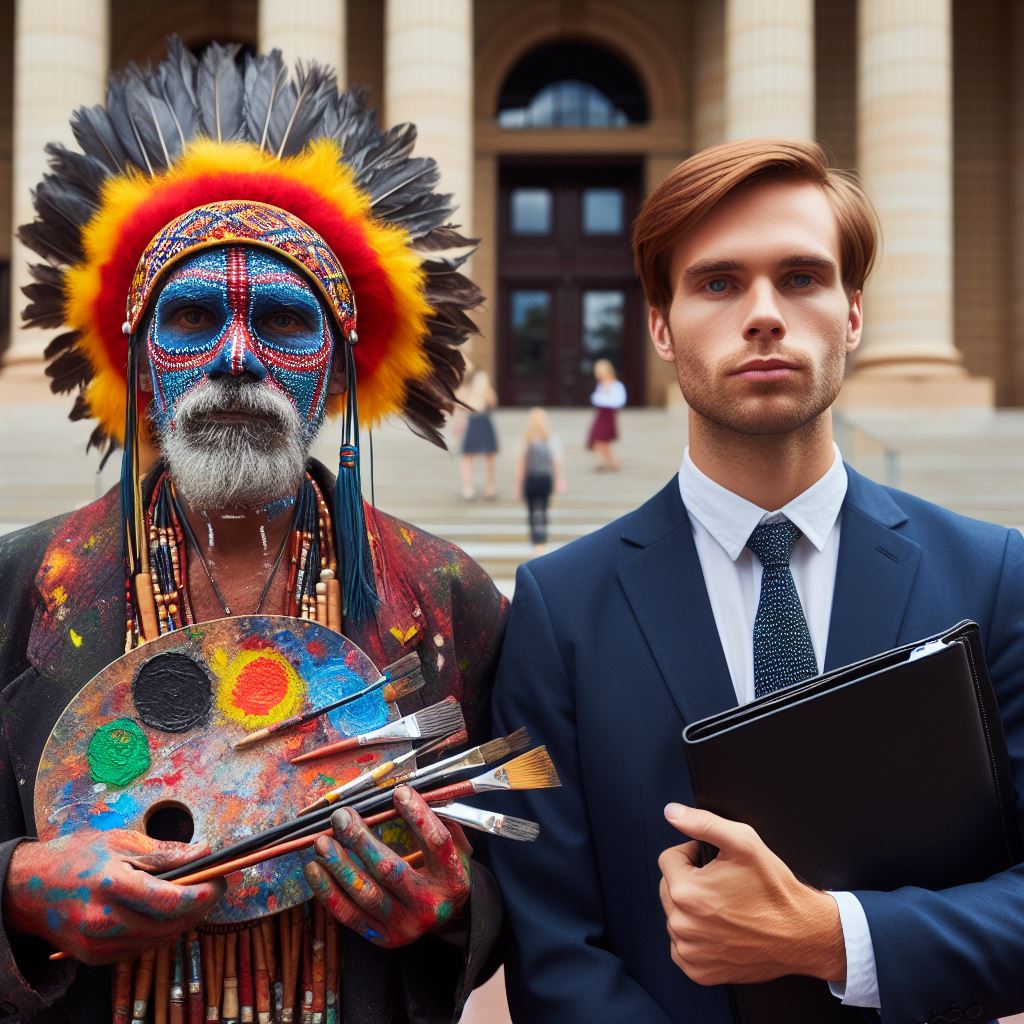Introduction
Art disputes, a nuanced facet of the Australian creative landscape, unfold as a compelling narrative at the intersection of artistic expression and legal intricacies.
This blog post navigates the intricate terrain of art disputes in Australia, delving into the complexities that artists encounter in safeguarding their creative endeavors.
At the heart of this exploration lies the multifaceted realm of art disputes in Australia.
These disputes, ranging from copyright conflicts to contractual disagreements, weave a narrative that reflects the challenges artists face in protecting their intellectual and creative investments.
As we venture into this domain, we unravel the stories behind contested brushstrokes, disputed lyrics, and debated designs that shape the discourse on artistic ownership.
Legal solutions emerge as crucial tools for artists grappling with disputes, providing a framework to safeguard their rights and artistic expressions.
This post underscores the significance of legal avenues in resolving conflicts, ensuring that artists not only retain control over their creations but also receive due recognition and compensation for their contributions to the cultural fabric of Australia.
Throughout this exploration, we will delve into the diverse landscape of art disputes, analyzing real-world cases, and examining the legal mechanisms available to artists.
From copyright protection strategies to contractual frameworks, we aim to empower artists with insights to navigate the legal nuances of their profession.
Join us on this journey as we unravel the layers of art disputes in Australia, emphasizing the pivotal role of legal solutions in fostering a thriving and equitable artistic ecosystem.
Types of Art Disputes
Art disputes can have a significant impact on artists’ careers and their ability to protect their creations.
Understanding the various types of art disputes is crucial for artists and professionals in the art industry to navigate the legal landscape and ensure their rights are respected.
Copyright infringement cases
Copyright infringement is a common type of art dispute that occurs when someone uses another artist’s work without obtaining proper authorization. This can include copying, reproducing, distributing, or displaying copyrighted material.
Examples of copyright disputes in the art industry are numerous. One case involves an artist who discovers their artwork being sold as prints by a third party without their consent.
Another example is when a musician samples a copyrighted song without obtaining the necessary licenses.
These disputes can be financially damaging to artists and can harm their reputation.
To protect their rights, artists can register their artworks with copyright offices and establish clear licensing agreements with others to prevent unauthorized use.
Intellectual property disputes
Intellectual property is of great relevance to artists as their creations fall within this legal category.
This refers to intangible works of the mind, such as artistic creations, inventions, and designs.
Artists often face disputes over the ownership and unauthorized use of their intellectual property.
For instance, if an artist creates a unique logo for a company, but the company begins using it without proper compensation or permission, a dispute may arise.
To prevent such disputes, artists can use contracts and licenses to protect their intellectual property rights.
They can also consider working with intellectual property lawyers who specialize in the art industry to ensure their works are properly protected.
Authenticity disputes
Authenticity disputes involve questioning the true origin or authorship of an artwork.
This can occur when multiple parties claim to be the creator of a particular artwork or when doubts arise about the legitimacy of a piece.
Famous cases of authenticity disputes in Australia include the Brett Whiteley and Sidney Nolan controversies.
In the Whiteley case, there was a dispute regarding the authenticity of several paintings attributed to the artist.
The Nolan case involved a dispute over the ownership of a collection of artworks.
These disputes are often complex and require thorough examination of expert opinions, artistic techniques, and historical context.
Courts and art experts play a crucial role in resolving authenticity disputes and determining the rightful origin and authorship of artworks.
In a nutshell, art disputes encompass various legal issues that artists may encounter during their careers.
Copyright infringement, intellectual property disputes, and authenticity disputes are just a few examples of the challenges artists face.
By understanding these types of art disputes, artists can take necessary steps to protect their rights and seek legal remedies when their works are unlawfully used or questioned.
Read: Melbourne’s Literary Scene: A Guide
Legal Solutions for Artists
Art disputes, especially in the realm of copyright protection, intellectual property rights, and establishing authenticity, are common in the Australian art scene.
Artists face numerous challenges to protect their creative work, both legally and commercially. This section explores these challenges and discusses legal solutions available to artists in Australia.
Copyright protection
Copyright protection is of utmost importance for artists as it grants them exclusive rights to reproduce, distribute, and display their work. Registering copyright is a crucial step for artists to ensure the legal recognition of their creative ownership.
Importance of registering copyright for artists
Registering copyright provides artists with several benefits. Firstly, it serves as evidence of ownership, creating a legal record that can be used in case of infringement disputes.
It also establishes a public record of the artist’s work, making it easier to prove authorship and resolve any conflicts that may arise.
How artists can enforce their copyright through legal means
If artists believe their copyright has been infringed, they can take legal action to protect their rights. This may involve filing an infringement lawsuit, seeking damages, and obtaining injunctions to stop unauthorized use.
The legal system provides artists with the necessary tools for enforcing their copyright and seeking remedies.
Intellectual property rights
Artists often face challenges in safeguarding their intellectual property rights, which encompass more than just copyright protection. Strategies beyond copyright registration can help artists protect their creative works.
Your Personalized Career Strategy
Unlock your potential with tailored career consulting. Get clear, actionable steps designed for your success. Start now!
Get StartedStrategies for protecting artists’ intellectual property
Artists can utilize various strategies to protect their intellectual property.
These include watermarking their artwork to deter unauthorized use;
Carefully controlling the distribution of their work, and incorporating technology that prevents digital reproduction.
By implementing these measures, artists can reduce the risk of infringement and protect the value of their creations.
Role of licensing agreements in safeguarding intellectual property
Licensing agreements play a crucial role in protecting artists’ intellectual property rights. These agreements set forth terms and conditions under which others can use the artist’s work.
By entering into licensing agreements, artists can retain control over the use and dissemination of their creations, ensuring that they benefit financially and maintain artistic integrity.
Establishing authenticity
Authenticity disputes can arise when doubts are cast on the origin or authorship of an artwork. Artists must take steps to establish and protect the authenticity of their work.
Methods artists can use to establish the authenticity of their artwork
Artists can establish authenticity by maintaining detailed records throughout the creation process. These records should include information such as dates, materials used, and any relevant documentation.
Additionally, artists can build a network of trusted experts who can provide authentication and expertise.
Legal recourse available for artists facing authenticity disputes
If an artist faces authenticity disputes, they can pursue legal recourse to protect their reputation and ensure their work is recognized. This may involve employing forensic analysis, seeking expert testimonies, and presenting evidence in court.
The legal system provides avenues for resolving authenticity disputes in a fair and objective manner.
In review, artists in Australia face various art disputes, but legal solutions are available to protect their interests.
By understanding copyright protection, intellectual property rights, and establishing authenticity, artists can navigate the complex legal landscape and safeguard their creative work.
Read: Salary Trends for Aussie Journalists
Learn More: Music Therapy: A Growing Field in Oz
Mediation and Arbitration
Define mediation and its benefits for resolving art disputes
- Mediation is a process where a neutral third party helps conflicting parties reach a mutual agreement.
- It allows artists to maintain more control over the outcome and find creative solutions.
- Mediation promotes open communication, understanding, and often leads to long-term resolutions.
- It is a less formal and less costly alternative to litigation, saving time and money for both parties.
- Mediation can be confidential, preserving the reputations of the involved parties.
How arbitration can provide a legally binding solution for conflicting parties
- Arbitration is a method of dispute resolution where a third party, an arbitrator, listens to both sides and makes a binding decision.
- The decision reached in arbitration is enforceable by law, providing a legally binding solution.
- It avoids the need for court trials, and the decision is often final and cannot be appealed.
- Arbitration can provide a quicker resolution compared to traditional litigation processes.
- It allows flexibility in selecting the arbitrator and the procedure, ensuring a fair process.
Role of professional mediators and arbitrators in art disputes
- Professional mediators are trained individuals who guide the parties through the mediation process.
- They facilitate effective communication, identify underlying issues, and help parties find common ground.
- Mediators remain neutral and impartial, ensuring a fair and balanced mediation process.
- They may possess knowledge and expertise in the field of art, enhancing their ability to understand the unique aspects of art disputes.
- Arbitrators, on the other hand, are selected by the parties involved or appointed by an arbitration institution.
- They assess the evidence presented by each party and deliver a final, binding decision.
- Arbitrators are often experts in the field of law or art, possessing specialized knowledge to understand complex art-related issues.
- Their role is to analyze the arguments and evidence, reaching a fair decision based on the applicable laws or industry standards.
- Both professional mediators and arbitrators play a crucial role in art disputes, ensuring fair processes and satisfactory outcomes.
- Their neutrality, expertise, and ability to facilitate communication contribute to resolving conflicts effectively.
- They provide artists with options beyond the courtroom, empowering them to seek resolution that aligns with their best interests.
In fact, mediation and arbitration offer viable legal solutions for art disputes in Australia. Mediation encourages open communication and creative problem-solving, while arbitration provides a legally binding decision.
Professional mediators and arbitrators bring expertise and neutrality to the process, guiding the parties towards fair resolutions.
By utilizing these alternative dispute resolution methods, artists can find efficient and satisfactory outcomes without the need for lengthy and costly litigation.
Read: Children’s Authors in Oz: A Special Niche

Case Studies
Real-life case studies of art disputes in Australia
- The Ashes of the Life Series: A dispute arose when an artist claimed a gallery copied their artwork without permission.
- The Stolen Sculpture: A sculpture was illegally removed from a public space, leading to a legal battle.
- Appropriation in Contemporary Art: A famous artist was sued for using copyrighted material in their artwork.
Legal solutions employed and their outcomes
- The Ashes of the Life Series: The artist filed a copyright infringement lawsuit and was awarded damages for the unauthorized use of their work.
- The Stolen Sculpture: The sculpture was recovered, and the individuals involved in the theft were prosecuted and fined.
- Appropriation in Contemporary Art: The artist claimed fair use and transformative intent, and the court ruled in their favor, citing freedom of expression.
Insights and lessons that can be learned from these cases
- Artists should always protect their work through copyright registration to safeguard against unauthorized use.
- Public art installations should have proper security measures in place to prevent theft and vandalism.
- Artists should be mindful of copyright laws and seek permission when using copyrighted material in their artwork.
- Proper documentation and evidence are crucial in art disputes to support legal claims and prove ownership.
- Legal action should be considered as a last resort, and alternative dispute resolution methods should be explored first.
- The outcome of art disputes can vary based on the specific circumstances and the interpretation of intellectual property laws.
- Artists should stay informed about their rights and legal options to protect their interests and art.
- Collaboration between artists and galleries should be based on clear contractual agreements to avoid potential disputes.
- The court’s interpretation of fair use and transformative intent in appropriation cases can significantly impact the outcome.
- Education and awareness about intellectual property laws can help prevent art disputes and promote a fair and ethical art industry.
By examining these real-life case studies, we can understand the complexity of art disputes and the importance of legal solutions for artists. It is vital for artists to protect their creative works, advocate for their rights, and seek legal remedies when necessary.
These cases also highlight the role of the legal system in resolving art disputes and shaping the landscape of the art industry in Australia.
Read: Australian Poets: Voices of a Nation
Conclusion
In retrospect, this blog post has meticulously navigated the intricate terrain of art disputes;
Shedding light on pivotal considerations for artists facing legal challenges.
We delved into the complexities surrounding intellectual property, contractual obligations, and the multifaceted nature of art-related conflicts.
The overarching theme underscores the need for artists to comprehend the legal nuances within the art world.
From copyright protection to dispute resolution mechanisms;
A comprehensive understanding of these aspects is vital for safeguarding the artistic endeavors of creators.
Crucially, the essence of our exploration rests on the profound importance of seeking legal solutions when confronted with art disputes.
Legal avenues provide artists with a structured framework to address conflicts, ensuring a fair resolution and protection of their creative rights.
By advocating for legal recourse, artists empower themselves to navigate the intricate legal landscape surrounding artistic expressions.
As we conclude, the proactive stance of artists emerges as a linchpin for the protection of their artistic rights.
It is incumbent upon artists to be vigilant, well-informed, and assertive in safeguarding their creative works.
Seeking professional legal advice becomes a proactive measure, offering artists the necessary expertise to navigate legal intricacies and uphold their rights in the face of disputes.
In essence, this exploration serves as a call to action for artists – an encouragement to not only be guardians of their creativity but also proactive advocates for their legal rights.
By understanding the legal landscape and actively seeking legal solutions when needed, artists contribute to the fortification of the artistic realm, ensuring that the fruits of their creative labor are protected and celebrated.




